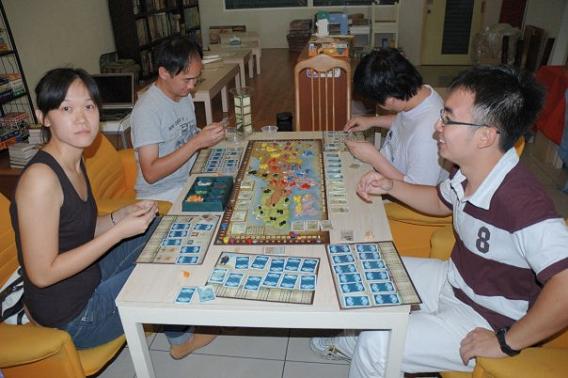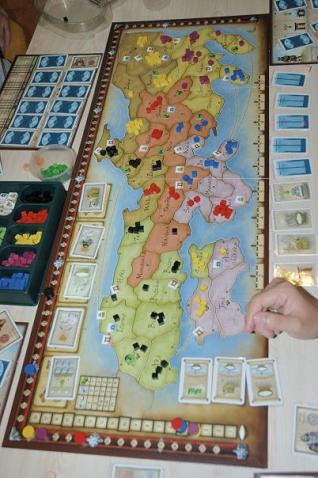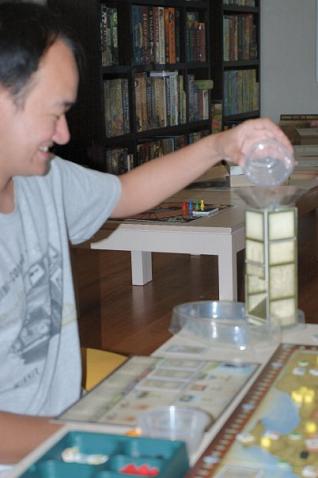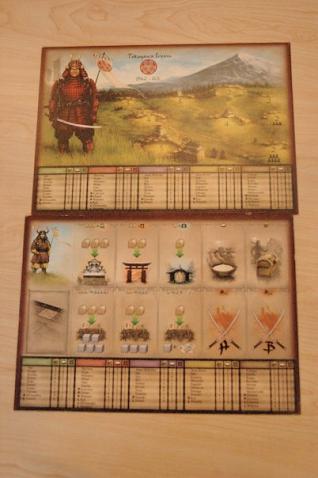
Shogun has earned a notorious reputation in my local gaming group as the game, together with its older brother Wallenstein, that one of our regulars absolutely refuses to play. Sean seemed enthusiastic about it and we were curious about what kind of game would elicit such an exaggerated reaction in Chee Wee, so a session was duly organized. The game is played on a board that represents Japan in the Warring States period during which the players represent various daimyo vying for the title of shogun. While it has armies and fighting, Sean kept insisting that it wasn’t a wargame and shouldn’t be thought of as one.
The reason for this is that players have a specific number of actions each round and while there are ten actions in total, only two of them allow attacks. Since there are only six rounds in the game during which actions are possible, that means each player can perform at most twelve attacks over the course of the entire game. Of the remaining actions, three enable construction of buildings that earn victory points, another three allows raising troops by spending money, one involves taxing a province to gain cash and the last one involves grabbing rice from the peasants of a province.
There are two distinctive things about Shogun. The first is that players decide what they intend to do each round simultaneously but secretly. They do this by placing the cards representing the provinces that they control face down on their player-specific board with spaces for the ten actions available. So you wanted to raise five troops in Yamato province for 3 treasure, you would play the Yamato province card face down on the space that allows that action. All of the action spaces must be filled but each player is also provided with a number of treasure cards that are used to bid for turn order. These cards can also be played on action spaces that you don’t intend to carry out.

The actual order that actions are carried out is randomized every round and players can only see the order for the first half of the ten actions. This has some obvious implications. For example, if an attack order is going to take place before the raise taxes action, you probably don’t want to try to raise taxes in a province that is vulnerable to being taken over. As the action spaces are resolved, each player flips over the card that they have over that space to reveal whether it is actual province or just a bluffing card and carry out the appropriate action.
The most distinctive element of course is still the infamous dice tower which is used to resolve battles. The game doesn’t use any actual dice. Instead, armies are represented by cubes colored according to each player. When a battle is called for, the cubes of both the attacking and defending side are gathered up are thrown into the tower. This tower is designed in such a way that it traps some of the cubes that go into it while letting the rest fall out. This means that if red fights yellow for example and each has five armies in the province, five red and five yellow cubes get thrown in, but what comes out might be a varied mix of differently colored cubes that went in previously.
Usually only the cubes of the two sides involved in the battle matter and the rest must be kept aside and thrown back into the tower for the next fight. Each cube cancels out one cube of the opposing side and the victor is whoever has any cubes left, representing the armies that remain in the province. However since the tower already starts pre-loaded with dice, it’s perfectly possible to have one side end up with more cubes in a province that he started the battle with! This is a frequent target of complaints as it’s so counter-intuitive and haphazard. Another complication is that there are also green cubes that represent the peasants. Basically if there is unrest in the province because the daimyo taxed them or seized their rice the peasants stand aside and do nothing in the battle. Otherwise the peasants help the defending armies.

The object of the game is to earn traditional Euro-style victory points. This comes from provinces controlled, possessing buildings in these provinces and having the most buildings of a type in a region of the map. Scoring takes place during a special round after three rounds of play have been completed. Since each round thematically represents a season of the year, the scoring round is considered as winter. This is also when rice becomes important as you need enough rice for all your provinces. If you don’t have enough then you consult the chart printed on the board to see how many peasant revolts you need to put down and fight them as battles against the green cubes.
After that all unrest markers are removed and gameplay continues for another year, at the end of which the victor is determined according to whoever has the most victory points. Overall, this means not only being able to hold provinces, but holding the ones with the most buildings, while at the same time being able to amass enough rice so that you won’t get too many rebellions. Fighting is important whether it is to capture provinces with valuable buildings or to secure your borders so that your inner provinces with buildings in them are safe, but it is equally important to manage the logistics of money to build and raise armies with and rice to feed your provinces with.
My own opinion is that it’s a solid enough game but I don’t think it’s really appealing to me in any way. I don’t share the hate that so many have for the dice tower as I can think of it as just another form of abstraction, but at the same time I don’t really see what it adds in terms of gameplay value. Unless the point is to encourage players to keep a running total of how many cubes of each colour are still stuck inside (which Sean actually tried to do, but I was too lazy to think about much), it seems to me that going with old-fashioned dice would be just as useful and would be more intuitive to boot.

After playing this game, I’ve cemented my earlier opinion about not liking games that force players to make a series of decisions all at once and then resolve them over the course of the round. This is also why I didn’t really like Dungeon Lords. Games should be about making interesting decisions on a continuous basis, but designs of this type front load all of the interesting decisions at the beginning and relegates the rest of the round to just mechanistically resolving the outcome. This means that players spend a lot of time at the beginning of the round silently contemplating the board and thinking about what to do and then the rest of the round is a flurry of action that is just make-work. I very much prefer designs like Agricola and even Die Macher in which lots of small decisions are spread out over the entire round and the player has immediate feedback on the results of their decisions.
One final point of criticism is that the map is blatantly unbalanced. Because it’s so long and narrow, the players occupying the two ends of the map should find it much easier to dig in and secure provinces from attack while the players occupying the middle section of the map need to watch out for attacks coming in all possible directions. After the session, Sean showed us the more balanced map used in the original Wallenstein which does look like it would make for a fairer game. Being somewhat interested in the history of the period however, I still prefer the theme in Shogun.
All things considered, I find Shogun to be a thoroughly average game that relies heavily on the novelty value of its dice tower gimmick. I’m still relatively new to the hobby but I’m beginning to see that many games make a name for themselves based on some new mechanic whether or not it actually results in a better game. Sometimes, such innovations eventually become mature and get incorporated into many different designs. Galaxy Trucker is a good example I think of a game that takes the tile building mechanic of Carcassonne and builds it into a better game. Unfortunately for Shogun, I don’t think its key idea is ever going to move beyond the gimmick stage.
(All photos used in this post were provided by Sean as I still don’t have a decent camera.)
6 Responses to “Shogun”
Actually i was exaggerating just to taunt sean 😛
but seriously this game is too long and too tiring… and the effort you put in doesn’t reward you with equivalent fun(almost boring at times).
You don’t need to memorize everything in the tower, just like Mamm Mia! Wait… you haven’t play mamma mia… next time i’ll teach you.
It is not fun when someone can memorize everything in a game. Then i’ll never play mamma mia with him/her.
chee wee: some 10 year old said this about vikings, but apply to all…
“10yo: It’s not boring! It has a very good theme, and if it is boring to you, then you are probably boring. If someone wants to have fun with a game, then the game they will play will be fun. It is what your attitude is….”
While it’s smart for a 10 year old to say something like this, I don’t agree with the point simply because it is so general that it applies to everything. Why not also say that tic-tac-toe can be a great game if only you play it with fun people? Making a statement like this invalidates all opinions about games.
Games are not created equal and some games are clearly better designed than others or appeal to specific niches better than others. This is why discussing about games is interesting. Otherwise, there would be no point in having any opinions about games.
ok… at least it applies to shogun.
Sometimes it is pointless to “discuss” with choo, you can try to explain why zealot cost 2 mineral, and zergling cost 1, he just wouldn’t listen.
Trackbacks
Leave a Reply